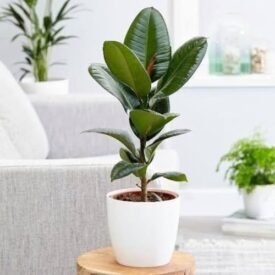Why Choose a Rubber Plant for Indoors?
The Rubber Plant is a favorite indoor plant around the world because it’s:
Low-maintenance and beginner-friendly
Visually striking with large, glossy leaves
Excellent for air purification (removes toxins like formaldehyde)
Tolerant of a range of lighting conditions
Fast-growing and adaptable to most indoor spaces
Whether in a home, office, or studio, it instantly adds a touch of greenery and sophistication.
What Makes It So Attractive?
Indoor plant lovers are especially drawn to its:
Large, leathery leaves that are deep green, burgundy, or variegated
Glossy finish, giving it a tropical, lush appearance
Upright growth habit, which adds bold vertical height in any room
Minimal care requirement, making it ideal for busy plant parents
This plant doesn’t just sit in the background—it makes a statement.
Special Capabilities
Air Purification: Removes harmful pollutants (NASA Clean Air Study, 1989)
Durable and resilient: Thrives in varied light and humidity
Growth-friendly: Easily pruned or shaped and grows quickly under the right conditions
Display Ideas to Boost Interior Design
Display the Rubber Plant in:
A large decorative pot to create a bold living room centerpiece
A modern plant stand to elevate it and emphasize vertical growth
A corner spot near a window, paired with smaller trailing plants for a layered look
It’s especially effective in entryways, hallways, or office corners where space needs personality.
Repotting Guide
Best Season to Repot:
Spring or early summer – during active growth
Best Time of Day:
Morning – allows full-day recovery and light exposure
Tools You’ll Need:
Pot with drainage holes
Well-draining potting mix
Trowel
Gloves
Pruning shears
Spray bottle
Tray or saucer
Plastic sheet (to protect surfaces)
Pot Tips:
Choose a pot 1–2 inches larger in diameter than the current one. Materials like terracotta or ceramic are great. Ensure good drainage to prevent soggy roots.
Indoor Environment Checklist
Factor Requirement
Light Bright, indirect sunlight preferred
Watering When top inch of soil is dry
Humidity Average indoor is fine (40–60%)
Temperature 60–80°F (16–27°C), no cold drafts
Air Flow Good circulation prevents fungal issues
Avoid over watering and direct sunlight, which can scorch leaves.
Pest & Disease Control
Common Pests Control Methods
Mealybugs – white cotton spots Wipe with rubbing alcohol
Spider mites – fine webbing, tiny red/brown dots Spray with neem oil or insecticidal soap
Scale – brown bumps Improve air circulation and light exposure
Aphids – clusters on new growt Rinse leaves with water for mite removal
Common Diseases:
Issue Signs Fix
Root Rot Yellowing, mushy roots Repot in dry, fresh soil
Leaf Spot Brown or black spots Remove leaves, use fungicide
Powdery Mildew White film on leaves Increase airflow, wipe leaves
Drooping Sagging, browning tips Adjust watering, stable temperature
Leaf Drop Shedding older/lower leaves Maintain consistent care routine
Fertilizer Tips
Category Details
Type Balanced NPK fertilizer (10-10-10 or 20-20-20)
Frequency Every 4–6 weeks in spring/summer
Application Dilute to half-strength and apply to moist soil
Organic Options Compost tea, seaweed extract, worm castings
Avoid fertilizing in winter.
Propagation Methods
Stem Cuttings (Most Common):
Cut below a leaf node
Root in water or soil
Transplant once roots reach 1–2 inches
Air Layering (For Larger Plants):
Slice stem, insert toothpick
Wrap with moss and plastic
Cut and plant once roots form
Leaf Cuttings:
Rarely successful for full plant growth
Stem cuttings and air layering are most reliable for propagation.
Pruning & Maintenance
Why Prune?
Control size
Encourage bushier growth
Remove dead or damaged leaves
How to Prune:
Cut above a leaf node
Remove no more than 25–30% at a time
Wear gloves – sap may irritate skin
Wipe leaves regularly with a damp cloth to remove dust and support photosynthesis.
Rubber Plant Care Summary
Task Frequency/Condition
Watering When top 1–2 inches of soil are dry
Light Bright, indirect light
Fertilizing Every 4–6 weeks in growing season
Repotting Every 1–2 years
Cleaning Leaves Monthly
Humidity Average; mist if too dry
Pruning As needed, especially in spring
Pest Check Monthly or with any signs of stress
Final Thoughts
Rubber Plants are bold, beautiful, and beneficial. Whether you’re a new plant owner or an experienced enthusiast, this plant rewards you with vibrant foliage and clean air for minimal effort.
Add a touch of tropical elegance to your home—with strength and style.

